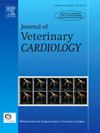Sudden cardiac death associated with severe atherosclerosis in a young dog
IF 1.3
2区 农林科学
Q2 VETERINARY SCIENCES
引用次数: 0
Abstract
A two-year-old female neutered wirehaired Dachshund presented with a four-week history of progressive intermittent pelvic limb weakness, pain and collapse episodes. Serum biochemistry revealed moderate hypercholesterolaemia and hypertriglyceridemia. Electrolytes and haematology were unremarkable. Thyroid and adrenal testing were unremarkable. Initial treatment for suspected spinal disease did not alleviate symptoms. The possibility of cardiac collapse was considered, a 24-h Holter monitor was placed, and additional blood was obtained to assess serum troponin I levels. Further cardiac investigations were declined.
While wearing the Holter monitor, the dog collapsed and experienced cardiac arrest, resulting in unsuccessful resuscitation attempts and death. The analysed Holter recording showed bradycardia-induced cardiac arrest, atrioventricular-block, and ST segment depression, suggestive of myocardial infarction or coronary spasm. A postmortem examination showed severe generalised atherosclerosis of the coronary, renal segmental, intervertebral, aorta, carotid, meningeal, and internal thoracic arteries. Severe multifocal myocardial fibrosis and necrosis was noted around the coronary arteries and papillary muscle. As the patient was very young and no other underlying cause was identified, primary hyperlipidaemia (hypercholesterolaemia and hypertriglyceridaemia) was deemed the most likely cause of the severe arteriosclerotic changes leading to sudden cardiac death.
幼犬严重动脉粥样硬化相关性心源性猝死
一只两岁的雌性绝育腊肠犬表现为四周进行性间歇性骨盆肢体无力,疼痛和虚脱发作。血清生化显示中度高胆固醇血症和高甘油三酯血症。电解质和血液学无显著差异。甲状腺和肾上腺检查无明显差异。对疑似脊柱疾病的最初治疗并没有缓解症状。考虑到心脏衰竭的可能性,放置24小时动态心电图仪,并获得额外的血液以评估血清肌钙蛋白I水平。谢绝进一步的心脏检查。戴着霍尔特监测器时,这只狗晕倒了,心脏骤停,导致复苏尝试失败和死亡。分析的动态心电图显示心动过缓引起的心脏骤停、房室传导阻滞和ST段抑制,提示心肌梗死或冠状动脉痉挛。尸检显示冠状动脉、肾节段动脉、椎间动脉、主动脉、颈动脉、脑膜动脉和胸内动脉存在严重的全身性动脉粥样硬化。冠状动脉和乳头肌周围可见严重的多灶性心肌纤维化和坏死。由于患者非常年轻且未发现其他潜在原因,原发性高脂血症(高胆固醇血症和高甘油三酯血症)被认为是导致严重动脉硬化改变导致心源性猝死的最可能原因。
本文章由计算机程序翻译,如有差异,请以英文原文为准。
求助全文
约1分钟内获得全文
求助全文
来源期刊

Journal of Veterinary Cardiology
VETERINARY SCIENCES-
CiteScore
2.50
自引率
25.00%
发文量
66
审稿时长
154 days
期刊介绍:
The mission of the Journal of Veterinary Cardiology is to publish peer-reviewed reports of the highest quality that promote greater understanding of cardiovascular disease, and enhance the health and well being of animals and humans. The Journal of Veterinary Cardiology publishes original contributions involving research and clinical practice that include prospective and retrospective studies, clinical trials, epidemiology, observational studies, and advances in applied and basic research.
The Journal invites submission of original manuscripts. Specific content areas of interest include heart failure, arrhythmias, congenital heart disease, cardiovascular medicine, surgery, hypertension, health outcomes research, diagnostic imaging, interventional techniques, genetics, molecular cardiology, and cardiovascular pathology, pharmacology, and toxicology.
 求助内容:
求助内容: 应助结果提醒方式:
应助结果提醒方式:


